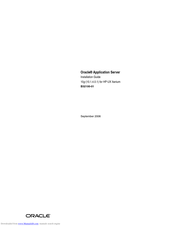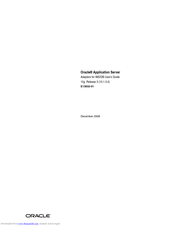Oracle Application Server 10g Manuals
Manuals and User Guides for Oracle Application Server 10g. We have 2 Oracle Application Server 10g manuals available for free PDF download: Installation Manual, User Manual
Oracle Application Server 10g Installation Manual (258 pages)
10g (10.1.4.0.1) for HP-UX Itanium
Table of Contents
-
Preface
13 -
-
Requirements19
-
-
-
-
-
Example97
-
-
Requirements111
-
-
-
-
Case 1: Client163
-
Case 2: Client164
-
Case 3: Client164
-
-
-
Ssl198
-
What to Do Next201
-
-
Pre-Installation208
-
Deinstallation218
-
-
Deconfig Tool223
-
Parameters224
-
D.1.1 Parameters224
-
Reinstallation230
-
-
Troubleshooting
230 -
-
General Tips231
-
Troubleshooting239
-
Log Files239
-
Need more Help252
Advertisement
Oracle Application Server 10g User Manual (170 pages)
Adapters for IMS/DB Release 3 (10.1.3.4)
Table of Contents
-
Preface
11 -
-
-
-
-
-
Requirements81
-
-
-
-
-
-
-
General Tab120
-
Columns Tab121
-
Indexes Tab125
-
Properties126
-
Statistics Tab126
-
Advanced Tab129
-
-
Adapter Metadata
131
-
-
-
Control
141 -
Logging
143 -
Security
145 -
Workspaces
147-
General147
-
Server Mode151
-
Security156
-
-
Advertisement

